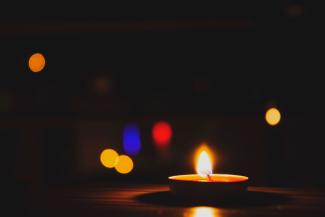Radiating Light This Epiphany

I love Epiphany.
At our home we celebrate Epiphany right after dinner on January 6, the Feast of the Epiphany in liturgical traditions. We turn off every light in our apartment. Then we recite the words from John 1, “What has come into being in him was life and the life was the light of all people.” Then we light a candle and go room-to-room inviting the light of Christ to fill every space in our apartment. We chalk our door with a blessing. We sprinkle holy water everywhere. And we sing “Joy to the World” as enthusiastically as the four of us can manage.
It really is great fun. Next year you’re all invited to the feast.
But actually, you still can celebrate Epiphany. In many liturgical traditions, Epiphany is a season, starting on January 6 and continuing until Ash Wednesday, when the 40 days of Lent begin. And as I said, I love it. Epiphany is where “O Come Let Us Adore Him” becomes “Go Tell It on the Mountain.” In Advent we spin inward in an effort to make room for Jesus’ coming. At Christmas we celebrate the beautiful and scandalous birth of Jesus. And in Epiphany we are sent out with the light of the beauty of the glory of Jesus shining in our faces to announce the good news. The darkness is past. A new day has come. The light has shined in the darkness and the darkness has not overcome it.
Light is the preeminent symbol of Epiphany. There’s an irony here. We speak of and celebrate light as a church in the heart of the season when our hemisphere seems wrapped in darkness. We know people who sit in front of full spectrum lights this time of year to help regulate their body to the diminished light. Many of us are up before dawn and return home after dusk.
Moving from the physical universe to the symbolic, the irony deepens. Our society is fragmented and fragmenting at an alarming rate. People are crying out for work, for justice, for security, for hope. The darkness is thick indeed. I think of the words of Hosea 4: “There is no faithfulness or loyalty, and no knowledge of God in the land. Swearing, lying, and murder, and stealing and adultery break out; bloodshed follows bloodshed. Therefore the land mourns, and all who live in it languish; together with the wild animals and the birds of the air, even the fish of the sea are perishing.”
And so, our family sits in darkness. The darkness whispers its formless menace. And a candle is lit.
To be clear, Epiphany is not for the faint of heart. It is not a season for idealists who believe that things are basically good and getting better, but then collapse in cynicism when confronted with darkness. Epiphany beckons us to come to the light of Jesus Christ. Epiphany calls us to stare into that light until our inner darkness is fully expunged. Epiphany then sends us out into a dark and weary world as women and men with shining faces, until we say with the apostle Paul, “It is the God who said, ‘Let light shine out of darkness,’ who has shone in our hearts to give the light of the knowledge of the glory of God in the face of Jesus Christ.”
The most literal illustration I can think of for this comes from the sixth film in the Harry Potter series, Harry Potter and the Half-Blood Prince. Toward the end of the film there is a tragic death that has been orchestrated by evil. The mission that brought about this death seems utterly futile. And hovering above this iconic fallen hero is the dark mark. The dark mark is an apparition in the clouds in the shape of a skull with a serpent protruding from its jaws. The mark is a symbol of intimidation. It taunts those who might resist with the indomitable power of evil.
In this scene, as the students gather in shock and horror, professor McGonagall silently lifts her wand. The end glows, like a candle, with a white light. Silently the others begin to do the same. More and more wands go in the air. White lights like candles mark the scene. The light reflects against the dark mark, and in a way that is both mysterious and beautiful, the dark mark dissolves from within.
This is not a sentimental moment. It is a moment of defiance. Holding up a light in a dark place is a dangerous thing to do. Maybe that’s why we find it so hard.
John 3:19 says, “Light has come into the world, but people loved darkness instead of light because their deeds were evil.” Holding up a candle risks exposure. Holding up a candle risks confrontation with the powers that thrive in the dark.
God’s call to us in Epiphany is to hold up a candle. We are being invited to make that move from coming and adoring to going and telling.
Every time the church emphasizes one of these to the exclusion of the other she gets distorted. When the church emphasizes “go and tell it” over “come let us adore him” she becomes hollow. Worship becomes spectacle. Ultimately this church loses itself. But when the church emphasizes adoration and inner well-being over “go and tell” it becomes anemic, timid, and sanctimonious.
We are healthiest as the people of God when we stare into the light of Jesus until our hearts burn within us and then we go out into the places we live, work, and play with faces that radiate this light. To quote Paul again, “And all of us, with unveiled faces, seeing the glory of the Lord as though reflected in a mirror, are being transformed into the same image from one degree of glory to another; for this comes from the Lord, the Spirit.”
So how do we radiate the light of Christ? Here are a few really practical ways in this season of Epiphany.
Radiating the Light of Christ Personally
How are you radiating the light of Christ in your life as an individual? What practices warm your heart to the reality of Jesus’ presence with you? How much time every day are you setting aside to sit in the presence of Jesus without any plans other than to know his love for you?
I read a statistic recently that said many clergy (up to 70% in some cases)—people you’d expect to be close with God because their work seems so closely dependent on it—pray for an average of 10 minutes a day.
How’s that going for you? Do you long for more?
This week I’d just invite you to keep track. How much time are you actually spending consciously aware of the presence of God, allowing his light to fill you?
We cannot give away what we do not have. A life of intimacy with God is impossible without spending time with God. For our face to shine with the light of Christ, we must spend time beholding his glory. (It should perhaps go without saying that to gaze on the face of Jesus is to turn our gaze away from ourselves. This is medicine we sorely need in a narcissistic age.)
The best way that I know to sit in the presence of God is to do what Christians have done throughout the centuries, the simple practice of holy reading. In holy reading you work your way through a section of Scripture slowly, attentively, asking simply, “How does this passage of Scripture point me to Jesus?”
So this week pay attention to your time with God. Perhaps consider holy reading.
Radiating the Light of Christ Relationally
It has always been the norm for Christian witness to take place in community. Our faces shine with the light of Christ together. We reflect the beauty and glory of Jesus best when we are connected to others in community.
How is that going for you? Are you a part of a community, whether a house church, or a ministry team, or a wellness circle? Is there space at your table for someone from a different generation, marital status, or educational background?
I’m convinced that there is nothing that better reflects the glory, beauty, and majesty of Jesus than when we the Church live and work together in unity and community. We are blessed to be a multi-generational, multiethnic, economically diverse Church. Let’s live into that this Epiphany.
When we are looking into the face of Jesus together with others, then it becomes natural to invite the people we live with, work with, and play with to experience that life as well.
So this week ask yourself, “Who am I connected with at church? Who are the people I’m connected to outside of church who need life with God?”
Radiating the Light of Christ as the Church
There is so much that shines with a holy light in the community of the Church. But, I fear, how easily we can miss the holy light. God is calling us to awaken to the holiness of Jesus present in our community and then to share this light with others.
Let me be clear: I’m not telling you to share what a great church you have. This is simply preaching about ourselves. No. We preach Christ and him crucified, and raised from the dead. We preach repentance and forgiveness of sin. We preach life in the gospel. We preach this as witnesses of the holy light of Christ. We hold up our candle. Our faces shine.
I love Epiphany. I love Epiphany because I love Jesus. The beauty and majesty of the glory of God as reflected in this scandalous and holy life captivates me. And I am convinced that the only hope for our dark, dark world is the light of Jesus.
My candle is my words. My candle is my willingness to stand with you and dare you to stare into the beauty of Jesus’ life, death, and resurrection until you are undone. My candle is to beat the drum of witness and sound the call to turn out into that place where you live, work, and play with a face shining and a candle burning bright.
Will you join me?
For more on Epiphany, download a free devotional here.




